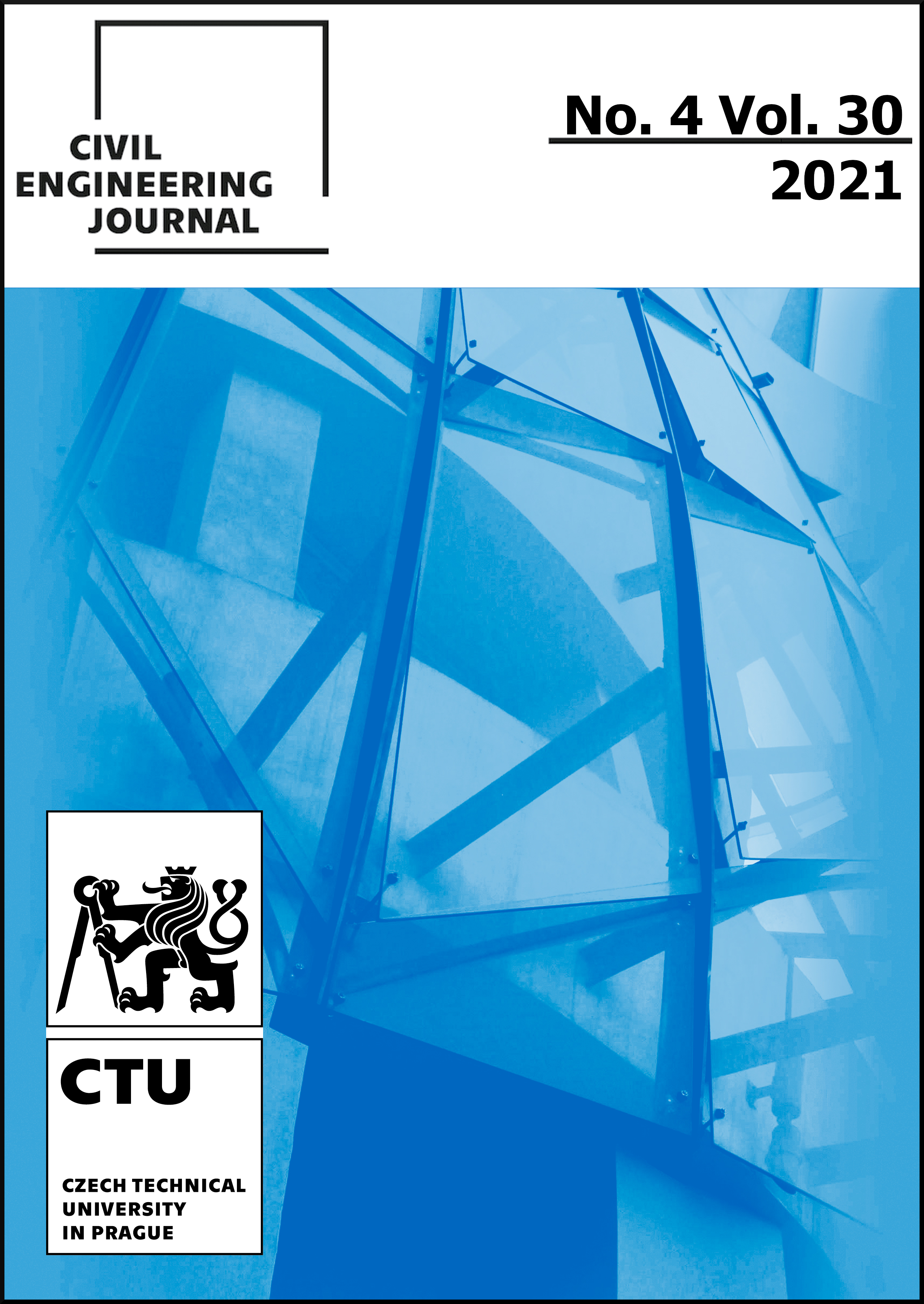EXPERIMENTAL STUDY ON MECHANICAL PROPERTIES OF POLYURETHANE POWDER COMPOSITES
DOI:
https://doi.org/10.14311/CEJ.2021.04.0067Keywords:
Polyurethane Cement (PUC) material, Mechanics Performance Tests, Polyurethane Powder Composites, Constitutive RelationAbstract
In this paper, the effects of emery, lime, quartz sand and cement on the mechanical properties of polyurethane powder composites were studied by three-point flexural test, and the stress-strain curve was drawn. In the flexural test, the polyurethane cement composite formed a control group by changing the content of polyester polyol. When polyester polyol: isocyanate: cement =1:1:2, the average flexural strength of polyurethane cement was 37.1 MPa, and the strain was 10854 με.When polyester polyol: isocyanate: cement =1.15:1:2, the average flexural strength is 38.9 MPa and the strain is 23520 με.When polyester polyol: isocyanate: cement =1.3:1:2, the average flexural strength is 42.5 MPa and the strain is 32942 με. The flexural strength and ductility are improved to a certain extent due to the addition of polyester polyol.The average flexural strength of other polyurethane powder composites such as polyurethane emery test block is 45.1 MPa and the strain is 6203 με, the average flexural strength of polyurethane lime test block is 33.4 MPa and the strain is 6470 με, the average flexural strength of polyurethane quartz sand test block is 49.23 MPa and the strain is 7521 με. The results show that the flexural strength of polyurethane emery material and polyurethane quartz sand material is higher than that of polyurethane cement, which can be used to replace cement to a certain extent to reduce the cost of polyurethane composite material.
Downloads
References
XUE, Rui, WU, et al. Research And Application Of Bridge Reinforcement[C]// 0.
D. Bennett. The history and aesthetic development of bridges[J]. Thomas Telford, 2008.
Podolny W , Fleming J F . History development of cable-stayed bridges[J]. Journal of the Structural Division, 1972, 98.
Fang R , Yang X . Cause and Countermeasure of Structure Disease of Bridge[C]// International Conference on Transportation Information & Safety. 2015.
Diao, Yan. Stone Arch Bridge Disease Detection and Evaluation[J]. Applied Mechanics & Materials, 2014, 501-504:1332-1335.
Zhongqiu F , Guyu S , Tong S , et al. Research on fatigue diseases evaluation of steel bridge deck based on fuzzy comprehensive method [J]. Industrial Construction, 2017.
Kang J T , Wang N , Liu C Z , et al. Study on Disease Analysis and Reinforcement Technology of Truss Arch Bridge[J]. Advanced Materials Research, 2011, 243-249:1972-1977.
Li H , F Liu. Bridge Inspection and Reinforcement Technology Application. 2015.
Zhu H , Yang Y , Fan W . External Prestressing Bridge Reinforcement Technology Review[J]. Matec Web of Conferences, 2015.
Wang Y , Zhu X , Hao H , et al. Corrosion-induced cracking of reinforced concrete beam : experimental study[J]. Applied Mechanics & Materials, 2009, 256-259(12):1148-1153.
Sonoda K , Okino M , Hayashi H , et al. Reliability of epoxy bonded steel plate method for repairing damaged RC slabs of bridge[J]. Proceedings of the Japan Society of Civil Engineers, 2010(398):245-254.
Zhao S W , Qiao X P . Experimental Study on Reinforced Hollow Beam with Carbon Fiber Reinforced Polymer and External Prestressed Strand[J]. Applied Mechanics & Materials, 2011, 94-96:495-499.
Gang, Zhishen, Wei, et al. Flexural strengthening of RC beams using distributed prestressed high strength steel wire rope: theoretical analysis[J]. Structure & Infrastructure Engineering: Maintenance, Management, Life-Cycl, 2014.
Quansheng SUN ,Yanqi WANG,Shengyan ZHANG. Experimental Study on Flexural Bearing Capacity of T-Beam Bridge Strengthened with Polyurethane Cement Steel Wire Rope [C]. Proceedings of the 9th Annual Conference of China Society of Highway Maintenance and Management Branch. 2019.
Shengran ZHANG. Experiment and finite element numerical analysis of polyurethane cement steel wire rope composite reinforcing bridge[D]. Northeast Forestry University, 2018.
Jianlin WANG, Guiwei LIU, lishui YE.Research on the application technology of strengthening hollow slab bridge with MPC composite material[J]. Highway,2013, 8: 39-43.
Hongxiang ZHANG, Chao CHEN, Tianlai YU. The application of simply supported beam strengthened by MPC material [J]. Low Temperature Architecture Technology, 2015, 3: 59-61.
Feng GAO.An experimental study on strengthening reinforced concrete hollow-slab girder using new material polyuethane-cement (MPC) [D]. Harbin Institute of Technology, 2016.
Dandan GU, Quansheng SUN.Study of Static Tests for Using MPC Composite Material to Strengthen Void Plate Girder Bridge[J]. World Bridges,2015, 43(6): 88-92.
Jiancai GUO, Yanqun ZHANG, Bingjun CHEN, Guiwei LIU.Reinforced concrete solid slab girder bridge reinforced with MPC composite materials[J]. Highway, 2017, 3: 126-130.
Haleem K. Hussain, Lianzhen Zhang, Guiwei Liu. An experimental study on strengthening reinforced concrete T-beams using new material poly-urethane-cement (PUC)[J]. Construction and Building Materails, 2013, 40: 104-117.
Haleem K. Hussain, Guiwei Liu, Yuwen Yong. Experimental study to investigate mechanical properties of new material polyurethane-cement composite (PUC)[J]. Construction and Building materials, 2014, 50: 200-208.
G Liu, H Otsuka, Y Mizuta, A shimitsu. A Foundational Study on Static Mechanical Characteristics of the Super Lightweight and High Strength Material Using Fly-ash[J]. Journal of the Society of Material Science Japan, 2006, 55(8):738-745
Downloads
Published
Issue
Section
License
Copyright (c) 2021 Author

This work is licensed under a Creative Commons Attribution-NonCommercial 4.0 International License.
Authors who publish with this journal agree to the following terms:
- Authors retain copyright and grant the journal right of first publication with the work simultaneously licensed under a Creative Commons Attribution License that allows others to share the work with an acknowledgement of the work's authorship and initial publication in this journal.
- Authors are able to enter into separate, additional contractual arrangements for the non-exclusive distribution of the journal's published version of the work (e.g., post it to an institutional repository or publish it in a book), with an acknowledgement of its initial publication in this journal.
- Authors are permitted and encouraged to post their work online (e.g., in institutional repositories or on their website) prior to and during the submission process, as it can lead to productive exchanges, as well as earlier and greater citation of published work (See The Effect of Open Access).
How to Cite
Accepted 2021-11-03
Published 2021-12-31











